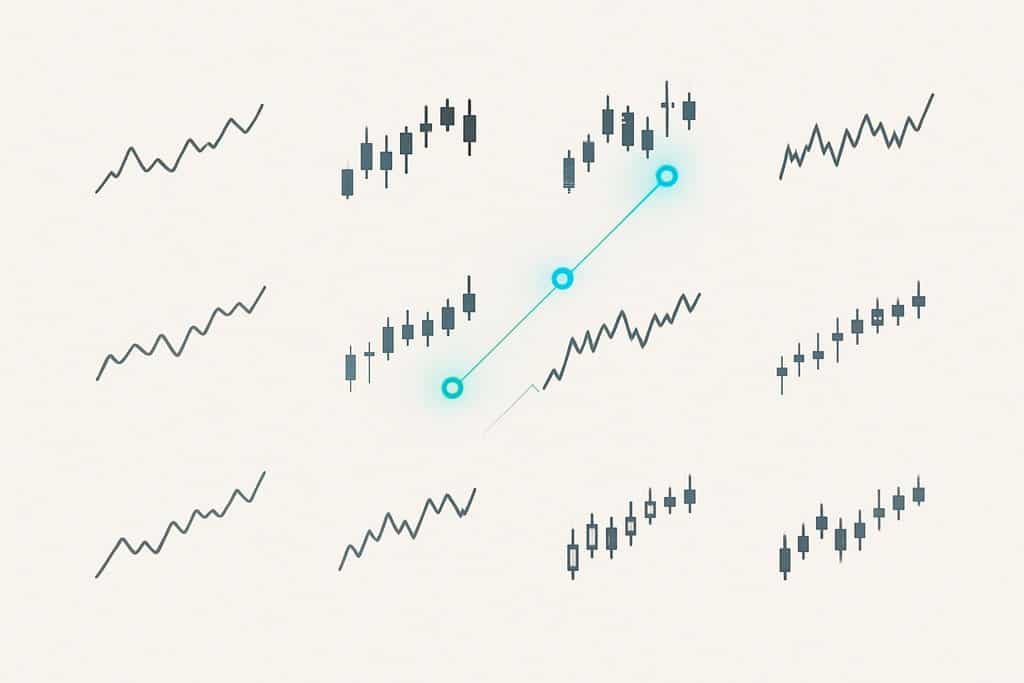Forex Trading AI: Turn FX Market Noise Into Signal
Learn how forex trading AI turns FX market noise into actionable signals. Build automated workflows with clear data, testing, and execution steps you can trust.

Contents
- What is forex trading AI
- Data and features that matter
- Modeling approaches that work
- Execution and risk management
- From idea to automation with Obside
- Step-by-step plan on Obside
- Benefits and considerations
- Conclusion and next steps
- FAQs
What is forex trading AI and how it differs from simple algorithms
Forex trading AI refers to systems that learn patterns in FX markets and turn them into decisions. Simple algorithmic strategies follow fixed rules such as buying when a moving average crosses another. AI introduces learning, adaptation, and probabilistic reasoning, so models can update as market regimes evolve.
An AI-driven setup ingests historical and real-time data, engineers features that capture price dynamics or macro context, trains models that forecast returns or breakout probabilities, and translates those predictions into entries, exits, and position sizing.
- Data ingestion: tick or minute data, spreads, liquidity, calendars like CPI and NFP, and text from statements or headlines.
- Feature engineering: RSI, MACD, volatility, ranges, session tags, cross-asset inputs like DXY or rates.
- Modeling: classification or regression forecasts (for example, the chance EUR/USD rises 10 pips in the next hour).
- Decision and execution: order types, risk limits, latency, and slippage control.
If you are new to FX microstructure, the foreign exchange market is deep and decentralized with liquidity concentrated during overlapping sessions. Spreads, funding, and economic news shape outcomes, which is why effective forex trading AI blends technical and macro features.
Data and features that matter in AI for forex trading
Quality inputs drive quality outputs. Design features that mirror how FX trades rather than throwing every indicator at a model. Start with price action and volatility: rolling returns, multi-window momentum, realized volatility, and range compression or expansion often seed directional and breakout logic. Normalize by volatility so signals remain comparable across sessions.
Technical indicators help when used as inputs, not rigid triggers. See RSI, MACD, and Average True Range for momentum, mean reversion, and dynamic stop sizing.
Session context matters. Strategies behave differently in London versus Asia. Tag time of day, day of week, and proximity to high-impact events to add structure. Macro surprises relative to consensus, central bank tone, and risk sentiment proxies often explain large intraday moves. Text features from headlines or policy statements can feed simple sentiment classifiers alongside price-based models.
Cross-asset influences add edge: DXY for dollar strength, short-term rate differentials, and rate curves. Even energy prices can correlate with currencies like CAD and NOK. Above all, keep features honest by using rolling windows and preventing lookahead.
Modeling approaches that work for forex trading AI
You can build effective systems without deep networks. Interpretable methods handle noisy, nonstationary data well. Classification models forecast direction or breakout probability; logistic regression, gradient boosted trees, and random forests are strong baselines with helpful feature importance.
Regression models forecast expected returns or volatility for position sizing and risk. Regularized linear models or tree-based regressors are often sufficient and easier to maintain. Sequence models like LSTMs or temporal convolutions can work if you constrain complexity, retrain frequently, and validate rigorously.
Use walk-forward testing: train on a rolling window, test on the next period, then keep walking. Evaluate trading outcomes such as net profit, maximum drawdown, and the Sharpe ratio. Consider calibration checks so a 60 percent signal wins near 60 percent over time.
Execution and risk management in AI-driven FX strategies
Great signals fail without disciplined execution. Microstructure realities shape results: spreads widen around news, liquidity thins during rollovers, and slippage eats edge if you chase. Build execution rules that account for time of day, spread thresholds, and order selection. Limit orders reduce slippage but risk missing moves; market orders fill quickly but require careful sizing and stops.
Risk management should live in the model and in execution. ATR-based stops adapt to conditions and normalize trades across pairs. Trailing stops can lock trends but must be sized relative to noise. Correlation risk matters; multiple USD pairs can behave like one concentrated position. Translate model confidence into position size within maximum risk bounds to reduce overtrading and focus on high-conviction contexts.
If you want to formalize these checks, learn how to structure testing in our guide on forex backtesting and explore trading automation to connect signals with real orders.
From idea to automation with forex trading AI on Obside
Designing and validating a strategy is half the equation. Execution speed, monitoring, and real-time reaction to news complete the loop. Obside turns natural language instructions into live alerts, automated orders, and fully managed strategies. You describe what you want, Obside Copilot builds it, backtests it, and runs it with your connected brokers and exchanges.
Example: “Notify me if RSI crosses 70 on EUR/USD and MACD turns bearish.” Obside watches the pair on your timeframe and pings you when conditions align. Or automate macro logic: “Sell EUR/USD if eurozone CPI misses consensus by 0.3 percent or more, then close after 8 hours or if 1h ATR expands 50 percent.” Obside handles news parsing, volatility checks, and timed exits. See how to choose platforms in best automated trading platform.
Notify me if RSI > 70 on EUR/USD and MACD turns bearish
If eurozone CPI < consensus by 0.3%, sell EUR/USD; exit in 8h or if ATR(1h) +50%
Obside’s ultra-fast backtesting engine validates strategies in seconds. Screen timeframes, measure drawdowns and win rates, and tweak rules without code. Once live, Obside executes with your brokers and monitors everything in real time. Explore the platform at beta.obside.com and create an account at beta.obside.com/register. For broader context on systematic design, read our guide on algorithmic trading.
A step-by-step plan to build your first forex AI strategy on Obside
1) Set a clear objective
Decide whether you want to capture trends on the 2 hour chart, mean reversion on the 15 minute chart, or breakout behavior around news. Your objective sets horizon, feature set, and risk rules.
2) Engineer features aligned with the goal
For EUR/USD trend logic, combine momentum over multiple windows, RSI as a regime filter, ATR for stop sizing, and a session flag to avoid quiet hours. Add calendar awareness to sidestep entries just before high-impact events.
3) Define trading logic with Obside Copilot
Describe rules in plain language: “When Supertrend turns bullish on the 2 hour chart, if RSI is not overbought and the 8 hour Supertrend is also bullish, then buy. Reverse for selling. Place a trailing stop at 5 ATR (2 hour). Close if the 2 hour Supertrend changes direction.” Obside translates this into runnable strategy parameters you can tune.
4) Backtest with healthy skepticism
Run across multiple years and check out-of-sample periods. Review return distributions, worst drawdown, and parameter sensitivity. If performance collapses around news, add filters that pause entries during those windows. See backtesting software for a practical framework.
5) Set execution and risk limits
Define maximum risk per trade, max open positions across correlated pairs, and a daily loss stop. Use ATR-based stops and targets so sizing scales with volatility. Block entries when spreads exceed thresholds to avoid unfavorable fills.
6) Go live in stages
Start with alerts, then paper trading, then small size. Compare realized fills versus backtests. If slippage is material, adjust order types or tighten spread filters. Obside lets you tune these details without code.
7) Iterate and adapt
Markets evolve. Retrain periodically or update rules as regimes shift. Use Obside monitoring to review performance by session, pair, and signal strength. Retire weak filters and lean into durable edges.
Try these starting points and refine fast with backtests:
- RSI divergence on 15 minute: buy bullish divergence, stop at the day’s low, 10 percent take profit measured via ATR units; add a 3 hour time stop.
- Cross-timeframe trend alignment: buy only when momentum agrees on 2 hour and 8 hour charts; trail stops to ride winners and reduce whipsaw.
- Macro surprise trading: if US CPI beats by 0.2 percent, buy USD against a basket; fade if volatility doubles and momentum stalls; throttle entries during extreme spreads.

Benefits and considerations of forex trading AI
AI can watch many pairs continuously, process technical and macro data together, and act without hesitation. You gain speed and consistency while enforcing risk rules precisely. Automated backtesting and monitoring promote discipline and reduce the urge to overreact to single trades.
- Real-time alerts and actions across pairs
- Consistent rules that reduce errors
- Fast backtests to validate changes
Consider the caveats. FX regimes change, and edges decay. Overfitting is a silent killer when you squeeze too much performance from a narrow backtest. Data issues like timestamp mismatches can leak future information. Execution friction matters around news or rollover. Prefer interpretable signals, conservative risk, and frequent validation.
A practical balance pairs simple, well-tested rules with light AI layers that refine timing or size. For example, a trend rule sets entries and exits while a small classifier adjusts size based on volatility structure and session context.
Conclusion: your next steps with AI in FX
Forex trading AI does not have to be a black box. Keep the pipeline straightforward, validate with walk-forward logic, and enforce risk discipline. Start small with one pair and timeframe, define clear rules in plain language, backtest, review drawdowns honestly, then automate.
Start simple, validate deeply, and automate only what you trust.
Ready to turn ideas into execution with Obside? Create an account and let Copilot build, backtest, and run your strategy automatically.
Create your free Obside account
Explore the platform, discover strategy templates, and connect your brokers and exchanges to run live logic with monitoring built in.
FAQs about forex trading AI
How profitable is forex trading AI in practice?
Profitability depends on data quality, signal design, risk management, and execution. Many traders see improved consistency rather than dramatic jumps in returns. Focus on stable edges, modest leverage, and controlled drawdowns. Validate with out-of-sample and walk-forward tests before risking capital.
Do I need to code to build AI-driven FX strategies?
Not necessarily. With Obside, you can describe your strategy in plain language and let the system build, backtest, and run it. Coding helps if you want custom models, but natural language rules, built-in indicators, and event-driven triggers already cover most use cases.
What timeframes work best for AI in forex?
All timeframes can work if features and execution match their microstructure. Short intraday horizons need low-latency execution and spread-aware entries. Higher timeframes rely more on robust regime filters and disciplined risk. Many traders start with 15 minute to 2 hour charts to balance signal frequency and execution friction.
How do I avoid overfitting in FX AI models?
Use rolling walk-forward validation, keep feature sets compact, and penalize complexity. Do not optimize on a single test period. Evaluate stability by slightly perturbing parameters and checking if performance holds. Track live metrics and be ready to deprecate models that degrade.
Can AI incorporate news and macro events in FX?
Yes. Build event-aware rules that pause entries or trigger trades based on economic surprises or central bank headlines. Obside can watch macro calendars and news conditions and execute based on your rules, for example buying USD if a surprise CPI beats expectations with volatility confirmation. See Trading News Hub for practical workflows.






